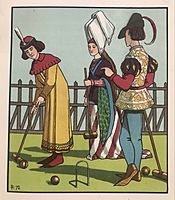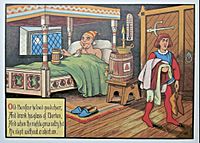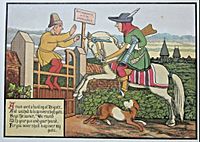James Edward Rogers facts for kids
Quick facts for kids
James Edward Rogers
|
|
|---|---|
| Born | 1838 |
| Died | 1896 (aged 57–58) |
| Nationality | Irish |
| Occupation | Architect and illustrator |
James Edward Rogers (born 1838 – died 1896) was a talented Irish artist, architect, and book illustrator. He started his career in Dublin, Ireland. Later, in 1876, he moved to London, England, where he mainly worked as an artist.
Contents
Early Life and Education
James Edward Rogers was born in Dublin. His father, also named James Rogers, was a barrister, which is a type of lawyer. James Jr. went to school in Dublin. Then he attended the Royal Grammar School in Guildford, England. After that, he went to Trinity College Dublin, starting when he was seventeen years old in 1855.
While studying, James became a student of Benjamin Woodward. Woodward was a famous Irish architect who was ill. Rogers visited Woodward's projects, like the Oxford Museum and the Oxford Union debating hall.
Rogers became friends with famous artists Dante Gabriel Rossetti and William Morris. They were painting murals at the Oxford Union. A friend, William Tuckwell, said the three of them would look for people to model for their art. This is how they met Jane Burden, who later married William Morris.
Rogers's good friend J. P. Mahaffy said James was Woodward's favorite student. Woodward traveled to warmer places like Madeira to help his health. In 1860, Rogers went to meet him in either France or Algeria. Woodward passed away in 1861.
Rogers finished his studies at Trinity College. He earned his Bachelor of Arts degree in 1861 and his Master of Arts degree in 1865.
Career as an Architect and Artist
Around 1862, James Rogers started his own architecture business in Dublin. By 1864, he had an office on Great Brunswick Street. In December 1864, he became a fellow of the Royal Institute of the Architects of Ireland. This meant he was a recognized expert in his field. He also joined their Council in 1868.
Rogers designed buildings like the Carmichael School of Medicine (1864). He also worked on churches, mostly for the Church of Ireland. He designed new churches and changed existing ones in different parts of Ireland.
While working as an architect, Rogers was also a landscape artist. He drew and painted beautiful watercolor scenes. His art was shown at exhibitions in Dublin starting in 1861. From 1870, he showed his paintings at the Royal Hibernian Academy. He became an associate of this academy in 1871. Many of his landscape paintings show places in Germany and the Netherlands.
Rogers also illustrated children's books. He created pictures for two nursery rhyme books: Ridicula Rediviva (1869) and Mores Ridiculi (1871). He also illustrated an edition of Dinah Craik's The Fairy Book in 1870. His colorful pictures were also used in Present Pastimes of Merrie England (1873).
In 1874, Rogers was elected a fellow of the Royal Institute of British Architects. This was another important recognition of his skills.
In 1876, Rogers moved from Dublin to London. After this move, he likely stopped working as an architect. He continued to show his paintings at the Royal Hibernian Academy until he died. He also exhibited his art at the Royal Academy of Arts in London starting in 1881. In 1889, he worked with his friend J. P. Mahaffy on a book called Sketches from a tour through Holland and Germany. He also illustrated Troubadour-Land (1891) by Sabine Baring-Gould.
Personal Life
In 1863, James Rogers married Anne Maria Yeo. They had four children together. Their first child, a boy, was born in 1864 but sadly lived only for a day. Their daughter, Ethel May Rogers, was born in 1865. In 1869, they had another daughter, Mary Francis Rogers. Their youngest child, Edward James Rogers, was born in 1872.
The family lived in different places in Ireland, including Chapelizod, Rathmines, and Ballybrack.
When they moved to England, they lived in various London neighborhoods. These included Maida Vale, Portman Square, Hampstead, and finally Regent's Park.
James Edward Rogers passed away in February 1896. His daughter, Ethel May Rogers, was in charge of his estate. He left behind a significant amount of money.
The National Gallery of Ireland has one of Rogers's paintings. It shows a street scene in Limburg, a small town in Germany.
| Article contributor: Anne Burns. |
Gallery
Books Illustrated by J. E. Rogers
- J. E. Rogers, Ridicula Rediviva (London: Macmillan, 1869)
- Dinah Craik, The Fairy Book (1870, illustrated J. E. Rogers)
- J. E. Rogers, Mores Ridiculi (London: Macmillan, 1871)
- J. E. Rogers, Present Pastimes of Merrie England (Cassell, Petter, & Galpin, 1873)








